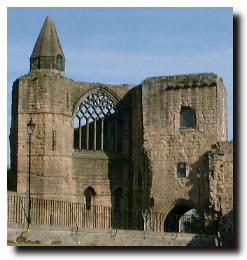
Famous Scots
- King Charles I (1600-1649)

Early Years
When Charles was born in Dunfermline Palace, on 19 November 1600, no-one knew that he would be the last king born in Scotland. He had an elder brother who was destined to be king and Charles was a frail, sickly child. Three years after the birth of Charles, his father, King James VI, became King of England also. His elder brother Henry, became Prince of Wales - an English title created by Edward I. But Henry died in 1612 and suddenly Charles became the heir apparent. But he was soon under the malign influence of the Duke of Buckingham, eight years older than Charles, who had been made a favourite of King James largely on the basis of his foppish good looks.In 1623, in pursuit of King James' plan to create an alliance with Spain, Buckingham accompanied Charles to the Iberian peninsula to arrange the marriage of the King of Spain's daughter to Charles. The plan was badly bungled (Buckingam gets the blame) and war was declared between Britain and Spain shortly after their return! As lord high admiral, Buckingham continued to mismanage various expeditions and was eventually murdered in 1628.
Monarch
King James died on March 27, 1625 and Charles was crowned at Westminster Abbey on February 2, 1626. With an alliance with Spain now abandoned, a French one was pursued instead, this time with a bit more success, and Charles married Henrietta Maria, the sister of King Louis XIII.His wife had an even more exaggerated view than Charles of the "Divine Right of Kings" which led him into conflict with Parliament both in Westminster and Scotland. Charles advocated the suppression of Puritanism in favour of a "high" church with richness and ceremony. He also claimed the right to raise money without the authority of Parliament. As the Members of Parliament resisted, Charles just dissolved the institution in January 1629 and ruled alone for eleven years. He was forced to raise money by devious means.
Charles eventually came to Scotland in 1633 to be crowned at Holyrood. Although the Union of the Crowns had taken place in 1603, the monarch ruled two separate countries, each with their own laws - and church. In Scotland the meddling of the king in church affairs led to the signing of the National Covenant in 1638 and a call to arms.
Civil War
The English Parliament and the Scottish Presbyterians were now both at loggerheads with the king and civil war broke out in 1642. In Scotland, the Marquis of Montrose carried out a brilliant campaign on behalf of the King. But in England, the battle between the Royalists and the Roundheads (led by Oliver Cromwell) swung back and forwards. But with defeats at Marston Moor in 1644 and Naseby in June 1645, his cause was lost in England. Charles therefore surrendered to the Scottish army in 1646. He tried to sow dissension between the Scots and the English Parliaments but he was eventually handed over to the English Parliament.Charles continued to attempt to "negotiate" but following an attempt to escape to France, rebellions in Wales and the south-east of England and an invasion of England by the Scots in 1648, convinced the English Parliament that Charles should be tried for treason. Charles argued (with some justification) that the court was illegal but he was sentenced to death and beheaded on January 30, 1649.
Despite his many failings, his refusal to compromise and save himself by accepting Presbyterianism, the illegal nature of his "trial" and his dignity at his execution, have all retrospectively provided Charles with a halo of martyrdom.
Return to the Index of Famous Scots
Where else would you like to go in Scotland?

